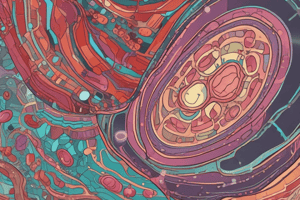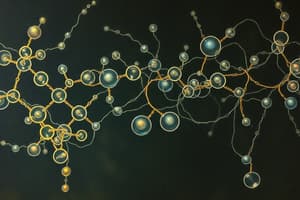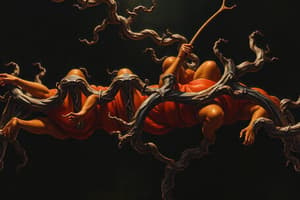Podcast
Questions and Answers
Which characteristic is NOT associated with mitochondria?
Which characteristic is NOT associated with mitochondria?
- Contains its own genome.
- Reproduces by fission.
- Primary site of ATP production.
- Bound by a single membrane. (correct)
The inner mitochondrial membrane's elaborate structure increases the organelle's capacity for which process?
The inner mitochondrial membrane's elaborate structure increases the organelle's capacity for which process?
- DNA replication
- Lipid storage
- ATP synthesis (correct)
- Protein degradation
Cardiac muscle cells require extensive arrays of mitochondria to:
Cardiac muscle cells require extensive arrays of mitochondria to:
- Synthesize contractile proteins.
- Maintain cell structure.
- Provide ATP for continuous contraction. (correct)
- Store excess glucose.
Mitochondria are described as dynamic organelles because they:
Mitochondria are described as dynamic organelles because they:
What would happen if a daughter mitochondrion does not inherit any mitochondrial genome during fission?
What would happen if a daughter mitochondrion does not inherit any mitochondrial genome during fission?
Most of the proteins found in the mitochondria are coded by:
Most of the proteins found in the mitochondria are coded by:
What is the purpose of adding energized mitochondria to a cell-free system after mitochondrial protein synthesis, followed by a protease?
What is the purpose of adding energized mitochondria to a cell-free system after mitochondrial protein synthesis, followed by a protease?
The matrix-targeting motif is located at the ___, and forms an alpha-helix that is ___.
The matrix-targeting motif is located at the ___, and forms an alpha-helix that is ___.
What is the predicted effect if you replace hydrophobic residues with hydrophilic residues in the matrix-targeting signal sequence?
What is the predicted effect if you replace hydrophobic residues with hydrophilic residues in the matrix-targeting signal sequence?
What is the consequence of adding a matrix-targeting motif to GFP?
What is the consequence of adding a matrix-targeting motif to GFP?
How does the import receptor recognize the matrix-targeting motif?
How does the import receptor recognize the matrix-targeting motif?
What is the role of Tom40 in protein import?
What is the role of Tom40 in protein import?
Cytosolic Hsc70 proteins bind to mitochondrial proteins as they are extruded from the ribosome to:
Cytosolic Hsc70 proteins bind to mitochondrial proteins as they are extruded from the ribosome to:
How does matrix Hsc70 contribute to protein import?
How does matrix Hsc70 contribute to protein import?
Why is it important to remove the matrix-targeting sequence after the protein enters the mitochondria?
Why is it important to remove the matrix-targeting sequence after the protein enters the mitochondria?
For a protein destined for the inner mitochondrial membrane, what additional sequence is required besides the N-terminal matrix-targeting sequence?
For a protein destined for the inner mitochondrial membrane, what additional sequence is required besides the N-terminal matrix-targeting sequence?
What is the role of the stop-transfer sequence in the import of a protein into the inner mitochondrial membrane?
What is the role of the stop-transfer sequence in the import of a protein into the inner mitochondrial membrane?
If a protein lacks a stop-transfer sequence but has a matrix-targeting sequence, where will it end up?
If a protein lacks a stop-transfer sequence but has a matrix-targeting sequence, where will it end up?
What is necessary for transport of proteins to the mitochondria?
What is necessary for transport of proteins to the mitochondria?
Defects in mitochondrial protein transport can lead to diseases, often associated with which condition?
Defects in mitochondrial protein transport can lead to diseases, often associated with which condition?
Flashcards
Mitochondrion Characteristics
Mitochondrion Characteristics
A double membrane-bound organelle, the primary site of ATP production, with its own genome and the ability to reproduce via fission.
Cristae
Cristae
These increase the surface area of the inner mitochondrial membrane, enhancing ATP synthesis capacity.
Intermembrane Space
Intermembrane Space
The region between the inner and outer mitochondrial membranes.
Mitochondrial Dynamics
Mitochondrial Dynamics
Signup and view all the flashcards
Mitochondrial Protein Destinations
Mitochondrial Protein Destinations
Signup and view all the flashcards
Mitochondrial Protein Import
Mitochondrial Protein Import
Signup and view all the flashcards
Matrix-Targeting Motif Necessity
Matrix-Targeting Motif Necessity
Signup and view all the flashcards
Matrix-Targeting Motif
Matrix-Targeting Motif
Signup and view all the flashcards
Import Receptor Function
Import Receptor Function
Signup and view all the flashcards
Translocation Channel
Translocation Channel
Signup and view all the flashcards
Hsc70 Chaperone Function
Hsc70 Chaperone Function
Signup and view all the flashcards
Unfolded Proteins
Unfolded Proteins
Signup and view all the flashcards
Matrix Processing Protease
Matrix Processing Protease
Signup and view all the flashcards
Stop-Transfer Sequence
Stop-Transfer Sequence
Signup and view all the flashcards
Stop-Transfer Mechanism
Stop-Transfer Mechanism
Signup and view all the flashcards
Protein Unfolding
Protein Unfolding
Signup and view all the flashcards
Study Notes
Post-Translational Transport to the Mitochondria
- The lecture describes the five steps of protein transport pathways.
- These steps are then identified in the mitochondrial pathway to understand transport.
- Experimental evidence is interpreted to support the model of transport.
- Apply the terms necessary in the transport of proteins to the mitochondria.
Characteristics of Mitochondria
- Bound by a double membrane with an interior and exterior membrane.
- Essential for ATP production.
- Proteins of the electron transport chain exist in the inner mitochondrial membrane.
- Possess their own genomes.
- Mitochondrial genes code for some of its proteins.
- Reproduce through fission.
Mitochondrial Structure
- Outer membrane surrounds the entire organelle.
- Inner membrane presents involutions called cristae that form distinct regions in the matrix.
- Cristae of the inner membrane increase the surface area for ATP synthesis.
- The region between membranes constitutes the intermembrane space.
- Mitochondrial regions are identifiable via electron microscopy.
- The inner membrane houses ATPase and the electron transport chain proteins
- The proteins convert nutrients into cellular energy (ATP)
- The structure increases the capacity to synthesize ATP.
Presence of Mitochondria in Cells
- Found in all cells, especially those needing a lot of ATP.
- Extensive mitochondria arrays reside in cardiac muscle cells that constantly provide ATP to fuel cardiac muscle contraction.
- Sperm cells require a lot of energy to maintain movement.
- Mitochondria form mitochondrial tubules that wrap around the axoneme of the sperm tail.
- Extensive mitochondrial networks are found in neural cells that require a lot of ATP.
- Mitochondria appear to form an elaborate network of tubules in neural cells.
Mitochondrial Dynamics and Genome
- Dynamic organelles change shape via fission and fusion.
- Mitochondria are in constant motion within the cytosol.
- They move, grow, and divide similarly to unicellular organisms.
- Contain multiple mitochondrial genomes.
- Undergo fission to produce two new mitochondria.
- Undergo fusion.
- Daughter mitochondria usually ends up with at least one mitochondrial genome during fission.
- Daughter mitochondria without a genome will degenerate and die.
- Mitochondria grow via the import of new proteins and genesis of new membrane.
Protein Destination and Origin
- Proteins are found in four locations within the mitochondria: outer membrane, inner membrane, intermembrane space, and matrix.
- Some proteins are coded in the mitochondrial genome and synthesized using mitochondrial ribosomes.
- Most mitochondrial proteins are coded by nuclear genes.
- Nuclear genes are transcribed in the nucleus and the mRNAs are translated in the cytosol by free ribosomes.
- Proteins are transported to the mitochondria in a post-translational pathway.
Testing Post-Translational Transport
- Hypothesis states that fully transported proteins can be transported into the mitochondria post-translationally.
- Mitochondrial protein synthesis is studied in a cell-free system.
- Polypeptides are combined with a mitochondrial signal sequence in a tube without ribosomes.
- Energized mitochondria get added first, followed by a protease which results with the proteins being protected.
- Energized mitochondria were not added and only the protease which resulted with the proteins being degraded.
- Fully translated proteins are transported into the mitochondria.
- Protein degradation is tested using an antibody to see if the protein localized within the mitochondria or through gel electrophoresis.
Mitochondrial Protein Transport Rules
- There must be a signal sequence.
- There must be a receptor for that signal sequence.
- There must be a translocation channel across the membrane.
- There must be a source of energy such as ATP hydrolysis.
- There must be a way of targeting proteins to different locations within an organelle.
Rules of Protein Transport to the Mitochondria: Signal Sequence
- The peptide signal sequence is known as the matrix-targeting motif.
- Located at the N-terminus, it contains 18 to 50 amino acids that form an alpha-helix.
- Specifically, it is an amphipathic helix (hydrophobic on one side, hydrophilic on the other).
- Positively charged hydrophilic residues and the hydrophobic residues are arranged in an alpha helix fashion.
Necessity of the Matrix Targeting Motif
- Hypothesis disruption of the amphipathic helix will inhibit the protein from reaching the mitochondria.
- Mutations disrupting the amphipathic nature of the helix will affect transport.
- Replacing hydrophobic residues with hydrophilic residues disrupts the helix.
- The matrix-targeting motif is required for protein transport to the mitochondria.
- Wildtype mitochondrial protein (with unmodified matrix targeting motif) are seen in the mitochondria.
- Mitochondrial protein with a mutant matrix-targeting motif remains in the cytosol.
Sufficiency of Matrix-Targeting Motif
- Matrix-targeting motif is needed for protein transport to the mitochondria.
- Adding the matrix-targeting motif to green fluorescent protein (GFP) re-localizes a protein from the cytosol into the mitochondria.
- Adding the motif results in the GFP no longer being diffuse, and can be seen in a punctate pattern.
- Localize a cytosolic protein into the mitochondria by simply adding the matrix-targeting motif.
- The matrix-targeting motif alone is sufficient for protein transport to the mitochondria.
Signal Receptor
- Matrix-targeting motif, is recognized by an import receptor that is embedded in the outer membrane of the mitochondria.
- The amphipathic helix of the matrix-targeting motif fits into the hydrophobic binding pocket of the import receptor.
- Hydrophobic residues of the amphipathic helix face into the hydrophobic pocket.
- The interaction facilitates recognition of the mitochondrial signal peptide sequence via the signal receptor.
Translocation Channel
- The translocation channel is also known as the general import pore (Tom40).
- The matrix-targeting signal then translocates from the import receptor into the general import pore.
- The protein is then shuttled through that translocation channel.
- The protein will continue straight into another translocon of the inner membrane (Tim44, Tim23, Tim17 complex), if targeted to the matrix.
- Two translocons are aligned at sites called contact sites.
- Proteins with a matrix-targeting motif move directly through both openings.
Requirement for ATP Hydrolysis
- Mitochondrial proteins are first translated in the cytosol then grabbed by cytosolic chaperone proteins (Hsc70).
- Hsc70 maintains the polypeptide unfolded to fit through the pores of the Tom and Tim translocons.
- Hsc70 function requires ATP hydrolysis.
- ATP hydrolysis is also needed in the mitochondria during protein transport by matrix Hsc70 proteins.
- The Hsc70 pulls proteins through the translocon by grabbing the unfolded proteins as they enter the matrix.
- This prevents the protein from moving backwards through the translocon.
- ATP hydrolysis drives a conformational change in Hsc70 and pulls the polypeptide into the matrix.
- Each Hsc70 protein binding creates space for another Hsc70 protein to bind.
Processing of Proteins Inside Mitochondria
- An unfolded protein must be processed after entering the mitochondria.
- Matrix processing protease removes the N-terminal matrix-targeting sequence.
- If the sequence is not removed, then prevents protein folding.
- Once the matrix-targeting sequence is removed, Hsc70 proteins assist in protein folding.
Protein Destination in Mitochondria
- Proteins destined for the mitochondrial matrix reach mitochondrial membranes.
- Transport to membranes requires a stop-transfer- sequence in addition to an N-terminal matrix-targeting sequence.
- Hydrophobic sequences are located in the interior of the protein sequence, and target the protein to the inner membrane.
Protein Transport to the Inner Mitochondrial Membrane
- The initial steps for transport of a protein into the inner membrane mirrors the transport into the matrix.
- N-terminal motif gets recognized by the import receptor and translocated through the Tom and Tim translocons.
- N-terminus of the protein appears in the mitochondrial matrix.
- The translocon of the inner membrane will then recognize the stop-transfer-sequence for the protein.
- The stop transfer sequence forms a hydrophobic alpha helix that stops translocation and directs transfer of the polypeptide out of the translocon into the inner membrane.
- The inner membrane translocon opens laterally and stops the protein from being pulled through the translocon.
- This exposes the stop-transfer-sequence is expose to the hydrophobic environment of the inner membrane.
- The hydrophobic alpha helix diffuses and the protein is embedded.
- Once the polypeptide has left, the Tim translocon closes
Stop-Transfer Sequence
- Stop-transfer-sequence is needed for transport into the inner membrane, but is not needed to get into the mitochondria.
- Adding only the stop transfer sequence will make the GFP protein stay in the cytosol.
- The stop transfer sequence alone is not sufficient for getting into the inner membrane.
- Proteins also need a matrix-targeting sequence in order to enter the inner membrane.
Importance of Protein Unfolding
- The cytosolic protein DHFR gets tagged with a matrix-targeting motif and a spacer sequence.
- Hsc70 proteins keep the DHFR protein unfolded, allowing it to be transported into the mitochondrial matrix.
- A matrix-targeting-motif can be sufficient for transport.
- Methotrexate can maintain the folded conformation of DHFR, despite Hsc70.
- Matrix targeting motif are successful in transporting the protein and some of the protein gets pulled through the translocons.
- The spacer sequence spans the two translocons and the matrix- targeting sequence is cleaved but the DHFR is folded so it cannot get through.
- Methotrexate added makes the DHFR aggregate in the cytosol at the contact site and cannot enter.
- Protein unfolding is necessary for transport of proteins to the mitochondria.
Mitochondrial Protein Import
- Mitochondrial protein transport follows the 5 rules for protein transport and constitutes a crucial process for cells.
- Defects might be caused due to mutations in targeting signals, the import machinery, or deficiencies in the chaperone (Hsc70).
- Often associated with neurodegeneration, mitochondrial protein import defects lead to diseases that affect any system within the body.
- Cells carry out post-translational protein transport to the peroxisomes and mitochondria.
- Proteins are targeted to the chloroplast post-translationally using an N-terminal targeting motif.
- Proteins are also targeted to the nucleus using a C- terminal nuclear localization sequence.
Protein Targeting Conclusion
- Protein targeting to the mitochondria follows the rules of post-translational targeting.
- Essential rules include a signal sequence on the transported proteins.
- There is a receptor for the signal sequence.
- Translocation channels must be available.
- ATP hydrolysis is required.
- A targeting mechanism for membranes or the interior of the organelle must be in place.
- Polypeptides must be unfolded when transported into the mitochondria.
Studying That Suits You
Use AI to generate personalized quizzes and flashcards to suit your learning preferences.




